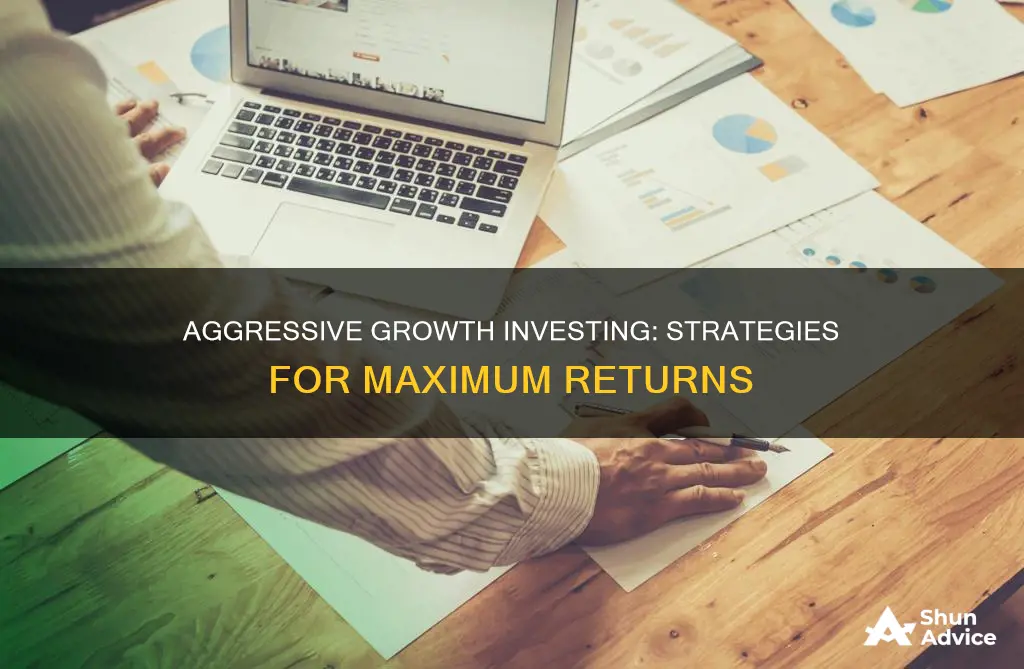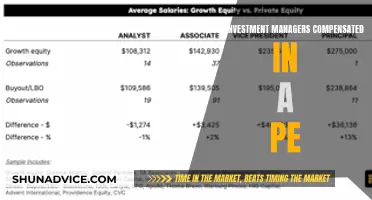
Aggressive investing is a strategy that takes on more risk to achieve higher returns. It involves investing in stocks, commodities, real estate, and other assets with high growth potential. This strategy is ideal for investors with a high-risk tolerance and a long-term investment horizon of at least five years. While aggressive investing can lead to significant gains, it also carries a higher-than-average risk of losing money. Therefore, it is generally recommended for young investors with smaller portfolios who can withstand market fluctuations and have a longer time to recover from potential losses.
What You'll Learn

Stocks
An aggressive investment strategy is a high-risk, high-reward approach to investing. This strategy is ideal for investors who are comfortable taking risks and have a long time horizon. Aggressive investing focuses on capital appreciation rather than capital preservation or income generation. This means that an aggressive investment strategy will have a substantial weighting in stocks and possibly little or no allocation to bonds or cash.
When investing in stocks as part of an aggressive investment strategy, it is important to remember that there is always risk involved. You could lose some or all of your money if the investment doesn't perform as expected. Therefore, a high tolerance for risk is an absolute prerequisite for an aggressive investment strategy.
There are different types of stocks that can be part of an aggressive investment strategy, including:
- Small-cap stocks: Shares in companies with a market capitalization of less than $500 million. They are considered riskier than large-cap stocks but can offer the potential for greater returns.
- Blue-chip stocks: Stocks from companies known for their ability to weather market conditions over the long term. These are considered less risky than small-cap stocks.
- Foreign stocks: Shares in companies located outside of the United States. This can be a riskier investment but also offers the potential for greater returns.
Additionally, investors can choose to invest in mutual funds, which are collections of stocks bought and sold by a professional fund manager. This allows investors to diversify their portfolio and invest in multiple stocks without purchasing them all individually.
Overall, stocks can be a crucial component of an aggressive investment strategy, offering the potential for high returns. However, it is important to carefully consider the risks involved and ensure that you have a high tolerance for risk before investing in stocks as part of an aggressive investment strategy.
Equities to Target in the Late Expansion Phase
You may want to see also

Real estate
REITs are companies that own and operate income-producing real estate properties. They are considered a more stable investment than stocks and offer the potential for higher returns. REITs can be easily bought and sold on major exchanges like stocks, and they pay dividends to investors. The dividends are possible because REITs, as corporations, are required to pay out 90% of their taxable profits to maintain their status. This makes them an attractive option for investors seeking regular income.
Rental Properties
Rental properties are a good choice for individuals with DIY skills, patience, and time to manage tenants and the property. While financing can be obtained with a low down payment, substantial cash is required upfront for maintenance and to cover periods when the property is vacant or tenants default on rent. Once the property starts generating income, the cash flow can be leveraged to acquire more properties, creating multiple income streams.
REIGs are ideal for those with some capital who want to own rental real estate without the hassle of hands-on management. They are similar to small mutual funds, pooling money from multiple investors to invest in rental properties. A single investor can own one or multiple units, while a company collectively manages all the units, handling maintenance, advertising, and interviewing tenants. In exchange, the company takes a percentage of the monthly rent.
Online Real Estate Platforms
Online real estate platforms, also known as real estate crowdfunding, allow investors to join others in investing in large commercial or residential deals. This option provides an opportunity to diversify into real estate without a large investment. However, many platforms require investors' money to be locked up for several years, making it an illiquid investment.
New York City Real Estate
New York City's status as a world capital in finance, fashion, marketing, entertainment, education, and technology makes it an attractive option for real estate investors. The city's expected population growth of 1 million people in the next 10 years will drive property appreciation.
Aggressive Strategies in Real Estate
Aggressive investment strategies in real estate may include a high turnover of chasing stocks that show high relative performance over a short period. This can lead to higher returns but also higher transaction costs and the risk of poor performance. Additionally, an aggressive strategy in real estate requires more active management than a conservative strategy due to its volatile nature.
Ophthalmology Practices: Private Equity Investment Opportunities
You may want to see also

Commodities
- Timing and Market Trends: The commodities market can be volatile, and prices can fluctuate widely. Keep an eye on market trends and try to time your investments to take advantage of favourable conditions. For example, in 2022, the Bloomberg Commodity Index returned over 16% due to increased demand and inflation. However, in 2023, the same index was down over 11% due to a slowing global economy, a milder winter, and an increase in commodity supply.
- Diversification: Spread your investments across different types of commodities to reduce risk. Commodities can be broadly categorized into three sectors: energy, metals, and agriculture. Diversifying your portfolio across these sectors can help minimize the impact of negative returns in any one sector.
- Geopolitical Factors: Geopolitical events can significantly impact commodity prices. For example, the Russia-Ukraine conflict affected the supply of energy, metals, and agricultural products globally, leading to a spike in commodity prices in 2022. Stay informed about geopolitical developments that may affect the supply and demand of commodities.
- Economic Growth: Commodity prices tend to be negatively impacted when economic growth slows. Slower economic growth leads to reduced demand for goods and services, resulting in decreased demand for raw materials. Keep an eye on economic indicators and adjust your investments accordingly.
- Supply and Demand: Understand the factors that influence the supply and demand of commodities. For example, extreme weather events or natural disasters can disrupt the supply of agricultural commodities, leading to price increases. Similarly, technological advancements or the discovery of new sources of energy or minerals can impact prices.
- Inflation: Commodities often serve as a hedge against inflation. When inflation increases, the prices of consumer goods go up, which in turn increases the demand and price of commodities used to produce those goods. Investing in commodities can help protect your purchasing power during inflationary periods.
- Risk Management: Commodities are high-risk investments. Be prepared for potential losses and ensure that you are comfortable with the level of risk. Consider setting stop-loss orders or using other risk management tools to limit potential downsides.
- Long-Term Horizon: Commodities are typically a long-term investment. Be prepared to hold your investments for several years or even decades to ride out market fluctuations and maximize potential gains.
- Active Management: Commodities require active management due to their volatile nature. Be prepared to adjust your investments as market conditions change. This may include buying or selling commodities, using derivatives to hedge risks, or rebalancing your portfolio to maintain your target allocation.
- Tax Implications: Understand the tax implications of investing in commodities. Consult with a financial advisor to ensure you are aware of any tax advantages or disadvantages associated with your investments.
Remember, investing in commodities for aggressive growth requires a thorough understanding of the market, a high tolerance for risk, and a long-term investment horizon. It is important to diversify your portfolio and stay informed about economic, geopolitical, and market trends that may impact commodity prices.
Understanding the Investment Management Division of the DOT
You may want to see also

High-yield bonds
Benefits of High-Yield Bonds
- Diversification: High-yield bonds typically have a low correlation to investment-grade fixed-income sectors, such as treasuries and highly-rated corporate debt. Adding high-yield securities to a broad fixed-income portfolio may enhance diversification and help decrease overall portfolio risk.
- Enhanced current income: High-yield bonds usually offer significantly greater yields than government bonds and many investment-grade corporate bonds. Average yields in the sector tend to rise during downturns when default risk also rises.
- Capital appreciation: An economic upturn or improved performance of the issuing company can positively impact the price of a high-yield bond. This capital appreciation is an important component of a total return investment approach. Events that can push up the price of a bond include ratings upgrades, improved earnings reports, mergers and acquisitions, management changes, positive product developments, or market-related events.
- Equity-like, long-term return potential: High-yield bonds and equities tend to respond similarly to the overall market environment, often leading to similar return profiles over a full market cycle. However, high-yield bond returns tend to be less volatile due to the larger income component, providing added stability.
- Relatively low duration: High-yield bonds often have relatively low duration because they tend to have shorter maturities, typically issued with terms of 10 years or less.
Risks of High-Yield Bonds
It's important to note that high-yield bonds are subject to certain risks, including:
- Credit risk: High-yield bonds are rated below investment grade due to a greater risk of defaulting on interest or principal repayments. As a result, they must offer higher coupons to attract investors.
- Market risk: High-yield bonds are sensitive to market conditions and can be negatively impacted by adverse market environments, such as downturns or recessions.
- Interest rate risk: While high-yield bonds are relatively less sensitive to interest rate risk compared to other fixed-income securities, they can still be impacted by rising interest rates, particularly in the recovery phase of the economic cycle.
When to Invest in High-Yield Bonds
When considering investing in high-yield bonds, it's crucial to assess the current economic conditions and market environment. High-yield bonds have been one of the best-performing bond investments in certain years, but there may be better entry points at other times. With the economy showing signs of slowing down, investors should be cautious about the risks posed by slower growth or a potential recession to the high-yield bond market.
Additionally, the yield advantage, or spread, that high-yield bonds offer above comparable treasuries may not always be significant. Investors need to carefully evaluate the potential returns versus the risks associated with high-yield bonds before making investment decisions.
In summary, high-yield bonds can be a valuable component of an aggressive growth investment strategy, offering the potential for higher returns compared to other fixed-income securities. However, investors should carefully consider the risks involved and ensure they have a long-term investment horizon to ride out any potential ups and downs in the market.
Home Purchase: Investment or Saving Strategy?
You may want to see also

Mutual funds
Aggressive growth mutual funds are a type of mutual fund that aims for high capital gains by investing in stocks with substantial growth potential. These funds are typically considered high-risk investments and are not suitable for risk-averse individuals.
Aggressive growth funds are a type of hybrid fund, investing 65-80% of their total assets in equity and equity-related instruments, with the remaining 20-35% in debt securities and money market instruments. This diversification helps to balance the overall volatility of the investment.
These funds are actively managed and offer flexibility in asset allocation, allowing fund managers to adjust the portfolio based on market conditions. They are well-suited for medium-term goals but are subject to market volatility, which can impact profitability. Due to their high-risk profile, aggressive growth funds are recommended for investors with a high tolerance for risk and a long-term investment horizon.
- Morgan Stanley Institutional Discovery MPEGX: This fund is known for its super-aggressive approach, investing in companies with strong business models and the potential for enormous growth.
- Vanguard Mid-Cap Growth VMGRX: This fund offers a cheap way to gain exposure to fast-growing companies, with fees as low as 35 basis points.
- T. Rowe Price Mid-Cap Growth RPMGX: This fund is managed by Brian Berghuis, who has a successful track record of investing in companies like Tesla and Netflix.
- ClearBridge Aggressive Growth Fund (SHRAX): As of March 2022, this fund held $5.7 billion in assets and had a year-to-date return of -8.7%.
- Quant Absolute Fund Direct Growth
- HDFC Hybrid Equity Fund Direct Plan Growth
- Groww Aggressive Hybrid Fund Direct Growth
- Edelweiss Aggressive Hybrid Fund Direct Growth
- Canara Robeco Equity Hybrid Fund Direct Growth
- JM Aggressive Hybrid Fund Direct Growth
Aggressive growth funds offer the potential for substantial returns but also carry a higher level of risk. Investors should carefully consider their risk tolerance and investment goals before investing in these funds.
Investing Guide: A Handbook for Indians
You may want to see also
Frequently asked questions
An aggressive investment strategy is a high-risk, high-reward approach to investing. It typically involves investing in stocks or other high-return, high-risk assets, such as commodities, foreign stocks, or high-yield bonds.
Aggressive investment strategies are generally suitable for young adults with a small portfolio size and a high tolerance for risk. A lengthy investment horizon is important as it enables investors to ride out market fluctuations and potential losses.
Aggressive investing can help protect your money from inflation by investing in assets that can offset the effects of inflation, such as stocks or commodities. It also offers the potential for higher returns over time.
The main risk of an aggressive investment strategy is that you could lose some or all of your money if the investments don't perform as expected. Aggressive portfolios are also likely to be more volatile and may require more frequent adjustments and rebalancing.
Before investing in any aggressive investments, it's important to consult a financial advisor to understand the risks involved and create a suitable portfolio for your risk tolerance. Common aggressive investments include stocks, real estate, commodities, and various types of funds.
Note: The above answers are for informational purposes only and should not be considered as financial advice.







